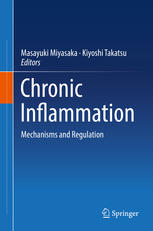Chronic Inflammation: Mechanisms and Regulation 2016
دانلود کتاب پزشکی التهاب مزمن: مکانیسم ها و تنظیم
| نویسنده |
Kiyoshi Takatsu, Masayuki Miyasaka |
|---|
| تعداد صفحهها |
702 |
|---|---|
| نوع فایل |
|
| حجم |
20 Mb |
| سال انتشار |
2016 |
89,000 تومان
این کتاب به روزترین اطلاعات در مورد آخرین تحقیقات در مورد التهاب مزمن را در اختیار خوانندگان قرار می دهد. اکنون می دانیم که وقتی التهاب مزمن می شود، به عنوان یک عامل قوی تقویت کننده بیماری در انواع اختلالات از جمله آترواسکلروز، چاقی، سرطان و بیماری آلزایمر عمل می کند. از این رو، التهاب مزمن “قاتل خاموش” نامیده می شود. به طرز موذیانه ای مکانیسم هموستاتیک بدن را به هم می زند. علیرغم این پیشرفت ها، ما اطلاعات کمی در مورد مکانیسم ایجاد التهاب مزمن داریم. به طور خاص، ما دقیقاً نمی دانیم که چه چیزی باعث التهاب مزمن می شود یا چه چیزی باعث طولانی شدن آن در چارچوب فضایی و زمانی می شود. همچنین دانش روشنی در مورد اینکه التهاب مزمن چگونه به بافتهای مختلف آسیب میزند یا اینکه چگونه افراد را مستعد ابتلا به بسیاری از بیماریهای مختلف میکند، نداریم. برای بدتر شدن وضعیت، ما درمان موثری در برابر التهاب مزمن نداریم.
از سال 2010، دو برنامه تحقیقاتی بزرگ (CREST و PRESTO) با هدف روشن ساختن مکانیسمهای التهاب مزمن در ژاپن راهاندازی شدهاند و محققان در زمینههای تحقیقاتی مختلف با سابقهای چشمگیر از طریق پیشنهادات تحقیقاتی خود انتخاب شدهاند. . پس از آن تمام تلاش خود را برای پاسخ به معمای التهاب مزمن انجام دادند. این کتاب خلاصه ای از این تلاش های پژوهشی است. در هر فصل، محققانی که توسط CREST یا PRESTO تامین مالی میشوند، کار اصلی خود را در مورد مکانیسمهای القاء، پیشرفت یا رفع التهاب مزمن خلاصه میکنند. بارزترین ویژگی، جنبه مولکولی التهاب مزمن است. بنابراین این کتاب آخرین پیشرفتها در درک مولکولی التهاب مزمن را ارائه میکند.
This book provides readers with the most up-to-date information on cutting-edge research concerning chronic inflammation. We now know that when inflammation becomes chronic, it acts as a strong disease-promoting factor in a variety of disorders including arteriosclerosis, obesity, cancer, and Alzheimer disease. Chronic inflammation is hence called as the “silent killer”; it upsets the body’s homeostatic mechanism insidiously. In spite of these developments, we know very little about the mechanism underlying chronic inflammation. Particularly, we do not know precisely what induces chronic inflammation or what promotes its prolongation in a spatiotemporal framework. Neither do we have clear knowledge about how chronic inflammation destroys various tissues or how it predisposes individuals to many different diseases. To make the situation worse, we have no effective treatment against chronic inflammation.
Since 2010, two major research programs (CREST and PRESTO) aimed at clarifying the mechanisms underlying chronic inflammation were launched in Japan, and investigators of different research areas with a brilliant track record were selected by their research proposals. Subsequently they have made their best efforts to answer the conundrum concerning chronic inflammation. This book is a compendium of such research efforts. In each chapter, the CREST- or PRESTO-funded researchers summarize their original work concerning mechanisms of induction, progression, or resolution underlying chronic inflammation. The most emphasized characteristic is the molecular aspect of chronic inflammation. The book thus presents the most recent progress made in the molecular understanding of chronic inflammation.




